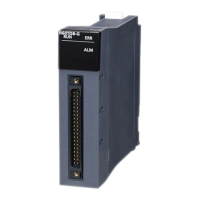552
32 TABLE OPERATION
32.3 How to Execute Multiple Tables
Operation
The following describes the operation of tables and flags in the continuous operation.
■Operation of the table
• Dwell time of the last table is the time until the complete flag turns on after deceleration stop.
• When tables are executed successively causing a direction change, deceleration stop is performed once and then output is
started in the reversed direction. The waiting time for the pulse output in the reversed direction after stop is "1 ms + scan
time".
• If the operation ends with an error when tables to be executed are left, the rest of the tables are not executed.
• If a table that cannot be combined is executed, the operation ends with an error. In this case, the table before the table that
cannot be combined is handled as the last table. After deceleration stop is performed for the previous table and dwell time
elapses, the abnormal end flag turns on. The dwell time of the previous table is used.
• Some control methods can be used with the remaining distance operation. (Page 374 Remaining distance operation)
■Operations by control method
• When a table with control method [0: No Positioning] is executed, all the tables are considered to be normally completed.
Then, the positioning complete flag turns on, and tables that follow the table with control method [0: No Positioning] are not
executed.
• The jump condition of control method [10: Condition Jump] is judged two tables before. (Example: If table 8 has control
method [10: Condition Jump], the conditions are judged when execution of table 6 is started.) When the jump-destination
table of control method [10: Condition Jump] has control method [10: Condition Jump], the conditions of control method [10:
Condition Jump] of the jump-destination table are judged at the same time.
■Operation with table (operand) setting
• Set the command speeds and positioning addresses of each table so that tables are switched once per 10 ms or less
frequently (except conditional jumps). If tables are switched more frequently than the above, table shift processing cannot
be completed in time and operation is decelerated to a stop and ends with an error. (The tables that have been read
operate normally.)
• The positioning address of the last table only can be changed in the case of continuous operation. Changes in the
positioning addresses of tables other than the last table are ignored.
• The positioning address of the last table can be changed both in the address increasing direction and address decreasing
direction. When the address is changed in the decreasing direction and the new address has already passed or when
pulses required for deceleration stop are insufficient for the new address, pulses are output in the reverse direction after
deceleration stop to reach the new positioning address. (The operation is the same as that of the DRVI/DDRVI and DRVA/
DDRVA instructions.)

